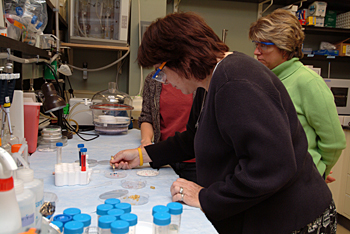
This year, however, Phalen's students will also get to see their teacher's cheek cells as revealed by a $500,000 confocal light microscope housed at the Bioimaging Laboratory at UD's Delaware Biotechnology Institute (DBI), where she recently participated in a hands-on microscopy workshop for teachers.
While the magnification provided by the confocal microscope is not much higher than with typical school microscopes, the resolution and detail of the image are significantly better due to the confocal's ability to focus on very thin slices within a thicker sample. Each slice can be photographed digitally, and a large number of images can then be processed with a computer to produce a three-dimensional animation of a trip through the cell or a rotation of the image. The cells can also be stained with a green fluorescent dye with an affinity for nucleic acids, making apparent the concentration of DNA and RNA within the nucleus.
The microscopy workshop was one of three presentations offered at DBI as part of an annual teacher in-service day designed to help Delaware's secondary science teachers keep up with advancements in their field. Fifty-eight teachers took part in this year's workshops, held Oct. 12. The workshops were supported by grants from NSF-EPSCoR and the DuPont Company. Additional sessions included “Bioethics and the Environment” and “The Living Dead: The Unique Role of Viruses in the Environment.”
All participating teachers received credit toward recertification. For some of the teachers, the in-service day was also a requirement toward joining a professional development cluster in biotechnology and the environment, a yearlong process for which they will receive a pay increase.
“I have been to the teacher in-service day at DBI for the last three years,” says Rose Lounsbury, a science teacher at the Charter School of Wilmington. “It is always extremely interesting and resourceful for me as a teacher. They do an excellent job of keeping us informed about new research that they are doing, and I often use the information I receive to tell my students what is going on these days in bio research. The kids are always amazed and ask many questions about what I learned.”

Tammy Averell, a 10th-grade teacher at Pencader Charter School, says that the microscopy workshop will be helpful to her in the classroom despite the fact that her students don't have access to electron microscopes. “We look at many microscopic images available on the Internet,” she explains, “and I think the kids often view these as cartoons. Now I'll be able to relate the process of how the images were created.” While the Bioimaging Lab is unable to accommodate visits by large numbers of students, the lab's director, Kirk Czymmek, says that DBI administrators are exploring ways to link the lab to schools remotely, through cyber infrastructure.
Averell adds that being able to provide insight into possible science careers is another benefit of the workshop. “Most of my students are not aware how suited their interests are to science careers,” she says, noting that student interests ranging from computers, to business, to art could all find an outlet working with microscopes, in addition to the scientist who uses the microscope for research or the technician who builds, services, or operates the instruments.
“We have a responsibility to provide our teachers with current and engaging information that results from life science research,” Miller says. “Teachers are a key part of the science community. Their enthusiasm and expertise lights the spark in students, who will shape our society and economy in the future.”
Article by Beth Chajes

